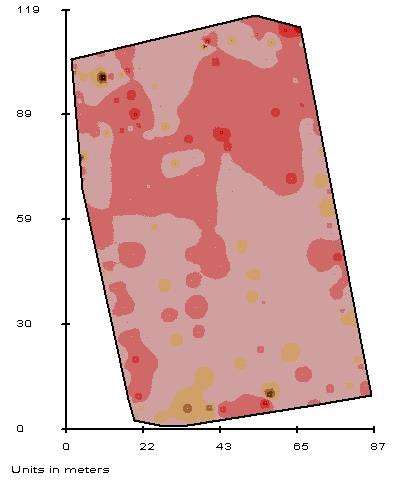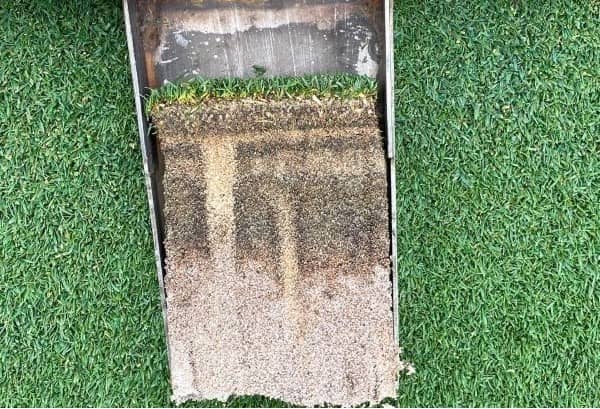Interactive Soil Compaction Calculator for Sports & Lawns.
(Research-Based).
Two common questions people ask are “When Does soil compaction occur?” and “How often do you need to aerate”. To help answer these, we have launched this on line calculator to help you figure this out.
We have reviewed numerous soil and turf research papers to develop this calculator. It takes into account:
- The soil type.
- Sport use.
- Drainage.
- Player age.
As time goes by we are aiming to improve this so that it becomes even more accurate.
How Soil Compaction Affects Turf.
When soil becomes compact, the pore space between soil particles reduces. This limits the movement of oxygen (O₂) and slows down gas exchange, and water movement through the soil profile.
- Turf roots then struggle to grow down into the soil. They tend to stay at a shallow depth.
- The turf becomes thin, weak, and slow to recover from any stress or wear.
- Compaction limits roots from being able to access water and nutrients. The turf tends to have a poor colour, doesn’t grow well, and a low overall vigour.
- Without remedial action, drought stress, heat injury, and nutrient deficiencies become far more likely.
Soil compaction is often called the “hidden enemy” of turfgrass. This is because it creates management problems by altering a soil’s physical properties.
Root and Shoot Impact.
- Compact soils restrict root growth. They limit the space roots have available to grow.
- This causes the grass to struggle to establish a deep root system, and leads to weak and thin turf.
Nutrient and Water Uptake.
- Nutrient uptake by roots is an active process. It needs the presence of oxygen (O₂) to occur.
- In fact, compact soils may reduce nutrient uptake by 10 to 30%. Often you can see this as chlorotic, N deficient turf.
- Compact soils stop water moving into the soil profile. This causes water to pool on the surface or run off. This can lead to erosion and nutrient losses.
Soil Compaction Increases Maintenance Costs.
Once a soil becomes compact it creates a cascade of management challenges:
Pest and Disease pressure.
- Soil compaction encourages weedy species like Plantains, Summer grass, Knotweed, Dandelions, Bindweed, and Chickweed.
- Low turf vigour plus favourable soil moisture can enhance diseases like Brown patch and Pythium blight.
Fertiliser Inefficiency.
If you make efforts to Increase N fertilisation it can make a bad situation worse. This is because the cause of any symptoms is not necessarily a nutrient deficiency but rather a result of limited root activity and viability.
Impact on Playability and Safety.
- Hard, compact turf has less shock absorption. This increases the risk of injuries and makes concussions more likely.
- Poor drainage leads to the water pooling at the surfac, increased disease pressure, and lower playability.
- Thin turf with weak roots is more likely to tear up during play. This creates safety hazards and extra maintenance.
- When the soil pore space is reduced by only10%, the turf will suffer.
The Soil Compaction Calculator.
This calculator was developed with the use of peer-reviewed data from STRI, Penn State, and UGA Extension. It is useful for councils, clubs, facility managers, contractors, asset owners, and lawn owners.
- It helps remove any guess work and calculates when to carry out aeration work.
- This calculator adapts the aeration schedule to take into account compaction drivers. These include: the soil texture, soil drainage, and traffic load. It doesn’t just give a generic recommendation.
- It counters under-aeration on high-risk sites such as clay based fields, heavy use sites and those with poor drainage.
- It avoids unecessary aeration wok on low risk sites like those subjected to low levels of use and sand constructions.
- This calculator helps improve overall turf health. This is because by preventing issues before they occur it prevents surface sealing, hydrophobicity, or root growth becoming issues.
- It improves disease and drought resistance. By dealing with compaction it enables good disease and drought defence by enabling good O₂/water exchange to continue.
- It reduces labour costs by matching aeration to need.
Australian Soil Compaction Diagnostic Tool
Estimate aeration frequency and compaction risk for turf areas.
- Baker & Richards (2005). Effects of Football and Rugby on Turfgrass Wear and Soil Compaction. STRI Technical Bulletin.
- Beard, J.B., & Green, R.L. (1994). The Role of Turfgrasses in Environmental Protection and Their Benefits to Humans. Journal of Environmental Quality, 23(3): 452–460.
- Carrow, R.N., Waddington, D.V., & Rieke, P.E. (2001). Turfgrass Soil Fertility and Chemical Problems: Assessment and Management. Wiley. [Publisher]
- Gilba Solutions. (2024). Sports Turf Agronomist Services - Field Usage Recommendations. Link
- Gilba Solutions. (2021). When is Soil Aeration Needed. Link
- McNitt, A.S., & Landschoot, P.J. (2003). Soil Physical Properties of Athletic Fields. Penn State Turfgrass Science. [Penn State Extension]
- Murphy, J.A., & Ebdon, J.S. (2011). Traffic Tolerance of Cool-Season Turfgrasses. Crop Science, 51(1), 1–10.

Jerry Spencer
Jerry has an Hons Degree in Soil Science (1988) from Newcastle Upon Tyne University. He then worked as a turf agronomist for the Sports Turf Research Institute (STRI) until 1993.
He gained a Grad Dip in Business Management from UTS in 1999. He has held a number of technical roles for companies such as Arthur Yates (Commercial Technical Manager) and Paton Fertilizers (Organic, turf specialty and controlled release fertiliser) portfolios.
In 2013 he established Gilba Solutions as independent sports turf consultants and turf agronomists. Jerry has written over 100 articles and two books on a wide range of topics such as Turf Pesticides and turfgrass Nutrition which have been published in Australia and overseas.


